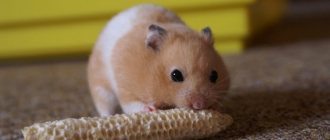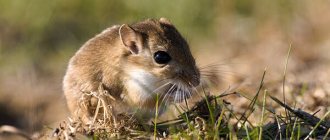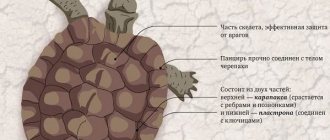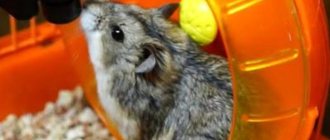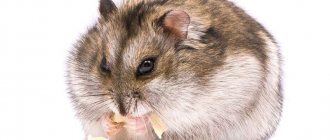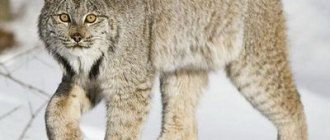Description of the rodent
— Advertising —
Hamsters are small rodents with a dense build, short legs, small ears and short tails. The body length ranges from 5 to 34 cm, the tail is from 0.7 to 10 cm in length. Females can exceed males in size. The fur is thick, the back is colored from ash or brownish-gray to dark brown-ochre. The abdomen is found in black, white or gray. There is a pronounced black stripe on the back. Hamsters also differ from other types of rodents in having well-developed cheek pouches.
Determining the sex of little rat pups
It is possible to distinguish boys from girls in little rat pups only on the fourth or fifth day. At this time, baby rodents do not yet have fur, so their sex can be determined by the papillae on their abdomen. Small pimples are arranged in two rows. If you see them, then you have a small female in your hands. If the mammary glands are not visible, then it is a male. Both small and adult males lack mammary glands.
In males, dark small spots are visible, which are located between the urethra and anus. These are future testicles that are still in the formative stage.
How else can you tell the difference between a female and a male? Indirect signs
Owners of pet rats who have experience in keeping more than three rodents can distinguish females from males not only by their physiological structure, but also by their appearance. Boys also differ from girls in behavioral characteristics.
- males are larger than females. Males are more powerfully built, females are more graceful;
- females have an oblong body, while males have the shape of a duchess pear;
- The fur skin of females is smooth, satiny-silky and soft. Males have a denser and stiffer coat;
- males are lazy and calm. They can sleep for a long time and spend a long time in their home without getting out. Girls are more active. They curiously explore the world around them. They cannot sit still for a long time. They actively try everything to their teeth;
- males are less aggressive than females. Girls can bite their owners. This happens if the rat is scared or has offspring that it is protecting;
- Rat owners distinguish between different sexes by the smell of their urinary secretions. In males, bowel movements are unpleasant, harsher and more caustic than those of the opposite sex.
Before purchasing tailed rodents, think carefully and look at the positive and negative aspects of having pets. Can you live together in the same space? Are you ready to care for them? If the answer is yes, go for it!
If you are just a lover of home decorative rats, then it does not matter to you whether it is a boy or a girl. They are all cute and wonderful, soft and fluffy little balls.
The rat is a social creature; it loves to communicate with its relatives and with people. They are tamed, walk around the apartment on their own or sit on the owner’s shoulder. Each member of their gender has features that you will love. Females are small, silky, warm animals that actively explore the space around them. Males are a little lethargic, but they will calmly lie on your legs and bask under your strokes.
You will receive incomparable pleasure from both of them!
Hamster nutritional features
Hamsters belong to omnivorous rodents, but their diet is dominated by plant foods. In addition, hamsters feed on insects and their larvae, small vertebrates (mice, reptiles and amphibians). In the autumn, they switch to seeds and tubers, and also store them in quantities from 0.5 to 11-16 kg. Sometimes hamsters' storerooms with grains and potatoes reach 90 kg. Hamsters also bring grain, peas, rice, millet, buckwheat, lupine, corn, lentils, potatoes to the pantries, putting different varieties of seeds separately. The hamster feeds on these reserves in the winter, temporarily waking up from hibernation, and in the spring until fresh food becomes available.
The hamster carries food in its cheek pouches, which contain about 46 g of wheat. Can carry food for about 1 km.
Reproduction
Hamsters form temporary mating pairs twice a year. Usually the male goes to the bride's burrow, where mating takes place. If a neighbor discovers a rival, a fierce battle ensues.
Pregnancy lasts approximately 21 days. Up to 10 babies can be born in a litter (less often 20). After 3 weeks, they can already feed themselves and leave their native land, settling in separate “apartments”. Family relationships are not supported in any way.
By the way, some researchers believe that the mother herself unceremoniously pushes the children out the door, preparing to accept the advances of the next groom.
Hamster spread
— Advertising —
Hamsters are widespread in Central and Eastern Europe, Asia Minor, Syria, Iran, Siberia, Mongolia, northern China and Korea.
The largest populations live in the forest-steppe and steppe. In the south it prefers damp areas, such as river valleys. In the mountains it is found at altitudes up to 3600 m above sea level, up to mountain meadows and forests. It also develops cultivated areas, such as rice fields, forest belts, parks, orchards, vegetable gardens, and residential buildings. Prefers dense soils, rare on sandy soils.
Common types of hamster
Common hamster (Cricetus cricetus)
The body length of adult males is 27-34 cm, the tail is 3-8 cm long, weight is about 700 g. The tail becomes thinner towards the end, covered with short, stiff hairs. The ears are short and dark. The fur is thick and soft. The color is bright and contrasting. The back is reddish-brown, the belly is black. On the sides there are two large light spots separated by black fur. There are also light spots on the sides of the head and behind the ears. There are specimens that are black or black with white spots on the legs and neck. In total, more than 10 subspecies of the common hamster have been described. The color becomes lighter from north to south, body size increases from west to east and from north to south.
The species lives in the meadow and forest-steppe of Eurasia from Belgium to Altai and Northern Xinjiang.
Syrian hamster, or Central Asian hamster (Mesocricetus auratus)
Body length is about 13 cm, tail up to 1.5 cm. Weight ranges from 100 to 125 g. The fur is soft, thick, golden.
It is found in nature near the Syrian city of Aleppo and in eastern Turkey.
Brandt's hamster or Transcaucasian hamster (Mesocricetus brandti)
Body length 15-18 cm, tail length 2-3 cm. Weight up to 300 g. Ears are small. The back is earthy brown. The belly is brownish-gray, there is a black spot on the chest. The sides of the head are yellowish-red, there are long black spots under the ears, and the chin is white. Paws are white. The fur is soft and thick on the tail.
The species' habitat includes Turkey, Israel, Lebanon, and the eastern Ciscaucasia. Inhabits steppes on mountain slopes, mountain meadows and cultivated areas.
Radde's hamster or Cis-Caucasian hamster (Mesocricetus raddei)
Body length up to 28 cm, tail length about 1.5 cm. The back is brownish. The belly is black or dark gray. There are light spots on the cheeks and behind the ears.
Distributed in Georgia and Russia, in the North Caucasus, in the Stavropol Territory and in the Ciscaucasia, in the steppes and forest belts.
Newton's hamster (Mesocricetus newtoni)
Body length 14-17 cm, tail length up to 2 cm, weight 80-150 g. The back is gray-brown, with a black stripe running down the center of the back. The neck and chest are black-brown, the belly is yellowish-gray.
Found along the Danube, in Bulgaria and Romania.
Djungarian hamster (Phodopus sungorus)
Body length up to 10 cm, weight 35-65 g. The gray back is decorated with a dark stripe, the tail is short. Fur with white spots.
Inhabits dry steppes and semi-deserts in the south of Western Siberia, Dzungarian Alatau, and Khakassia.
Campbell's hamster (Phodopus campbelli)
Body length is 7-10 cm, the tail is short, up to 1.5 cm long, weight is about 25 g. The head is rounded, the muzzle is short. The fur is dark gray with a brown tint, there is a dark stripe on the back, and the belly is gray.
The species is distributed in Mongolia, northern China, Russia and Kazakhstan.
Roborovski's hamster (Phodopus roborovskii)
A small species with a body length of 4-5 cm, weighing about 30 g. The head and back are sandy-golden, the abdomen is white. Light spots are visible above the eyes.
Found in Mongolia, China and Russia.
Short-tailed hamster (Cricetulus alticola)
Body length is 8-10 cm, weight ranges from 22 to 48 g. The fur is gray-yellow-brown without spots.
It lives in the north of South Asia and China, at altitudes of about 4000 m above sea level, in coniferous and birch forests, and in the steppes.
Barabinsky hamster (Cricetulus barabensis)
Outwardly similar to an ordinary hamster. Inhabits forest-steppe and semi-deserts in the south of Western Siberia, Tuva, Transbaikalia, Mongolia, northeast China, Primorye (Russia) and Korea.
Gray hamster (Cricetulus migratorius)
Body length 10-13 cm, tail 2-3.5 cm long. The coat is gray on top, the belly and tail are light. The eyes are large. The ears are small.
The species' habitat includes Eastern Europe, Russia, Asia to western China.
Sokolov's hamster (Cricetulus sokolovi)
Body length from 7 to 11 cm, tail length up to 3 cm. The back is gray with a dark stripe. The abdomen is light gray. There are dark brown spots in the center of the ears.
Found in sandy areas of Mongolia and China.
Mongolian hamster (Allocricetulus curtatus)
A small species with a body length of 10-15 cm, a tail 1.5-2 cm long. The color is light, the tummy, tail and paws are white. The tail is fluffy.
It lives in the Zaisan depression in the south of Tuva, China and Mongolia.
Eversman's hamster (Allocricetulus eversmanni)
Body length 13-16 cm, tail 2-3 cm long. Paws are short. The ears are small. The tail is wide, flattened, densely pubescent. The fur is short, soft, velvety. The back is blackish-brown or fawn-red or ash-sandy. The belly is white with a sharp border on the sides. There is a brown spot on the throat and chest. The paws and tail are white below.
Lives in the Lower and Middle Trans-Volga region, in the south of the Trans-Urals, in Kazakhstan.
Kansky hamster (Cansumys canus)
Body length from 10 to 17 cm, tail 7-10 cm. Weight from 60 to 120 g. The coat is thick, the back is gray with white spots on the cheeks and near the ears. The belly and tip of the tail are white.
The species is distributed in central China.
Rat-like hamster (Tscherskia triton)
Body length from 14 to 25 cm, tail 7-10 cm long. Weight from 92 to 241 g. The back is light gray-brown, the tail is dark brown with a white tip, the paws are white.
The habitat includes northeast China, the south of Primorsky Krai, and Korea.
Preparing your hamster for examination
It should be understood that during sex determination, the main thing is not to harm the pet. For him this is already a huge stress. An animal unaccustomed to hands may try to jump out of the hands and bite the owner. And they bite so painfully.
Before determining the sex, the hamster needs to be prepared a little and favorable conditions created.
It is worth choosing a moment when the Syrian hamster is in a calm state, usually in the middle of the day or late evening. Treat him to something sweet, pet him, and only then pick him up. It is also necessary to determine the location for inspection. The hamster may feel threatened, begin to resist and slip out of your hands, so it is recommended to provide a soft surface.
If the hamster becomes aggressive and starts to break out of your hands, there is no need to hold it by force. It is necessary to return him to the cage and wait for the right moment.
In addition, the person who will perform the examination also needs to prepare for the gender determination procedure.
Hands must be clean and free of foreign odor. It is better to wash your hands under running water, without using soap, and then dry.
Hamster behavior
Hamsters are terrestrial animals; some species can swim by taking air into their cheek pouches. They usually live alone, in burrows. Outside the breeding season, hamsters behave aggressively towards their relatives and often start fights. In winter, they fall into a prolonged torpor, which is still not real hibernation.
Hamsters are characterized by a twilight lifestyle. During the day they remain in their burrows, which reach 8 m in length and 1.5 m in depth. May occupy gopher burrows. In a permanent burrow there are from 2-5, sometimes up to 10 exits, a nesting chamber and storerooms.
Lifestyle
It lives underground, making a deep (up to two meters) and long (up to 8 meters) burrow. Such a dwelling has its own storage room, several nests for rest, up to five, less often ten entrances and exits. In rare cases, a gopher or other burrowing animal may take over the house.
The floor in the hole is lined with straw. Each “door” has its own function:
- Usually a gentle descent into a hole is the way out.
- The more vertical hole is the entrance, through which the animal returns home; it especially likes to use it in times of danger.
- The third tunnel leads to the “storage room”.
During the winter, the hamster plugs all the holes with earth.
The animal is very clean, its house is a standard of cleanliness, it never “soils” in the living area, and especially in the storage area, and uses special latrines for this.
The common hamster is a loner and forms temporary pairs only during the mating season.
In everyday life he is aggressive and pugnacious. If there is a mortal threat, it can even rush at a person.
The animal has a terrifying appearance: it stands on its hind legs, snaps its teeth and moves to attack.
Natural predators for the rodent are foxes, ferrets, stoats, eagles, owls, and eagle owls.
In winter, the animal hibernates, occasionally wakes up to eat and goes back to sleep. During mild and warm winters they often wake up and even come to the surface.
Pet hamsters
At home they keep Syrian, Djungarian, Campbell and Roborov hamsters. Syrian hamsters come in a wide variety of colors, patterns, and coat types. Long-haired Syrian males are sometimes mistakenly called "Angora".
When choosing a hamster, take into account that Roborovsky hamsters can live in flocks, while other species are solitary, and when they are kept together, fights arise, which often lead to the death of the weaker of the hamsters. When hamsters of different sexes are kept together, the female gives birth very often, which harms her health and shortens her life. A pregnant female is capable of killing or injuring a male while protecting her cubs.
The dimensions of the cage for hamsters must be at least 50 cm by 30 cm. A wheel with a running surface (14-18 cm in diameter) must be installed in the cage. Eating at home is no different from eating in nature. The diet is based on cereals and green plants.
For mating, a pair is selected from a male aged 4 months and a female aged from 9 months. They are brought together on neutral territory or in a male’s cage during the female’s estrus period, which occurs for several hours every 4 days. Pregnancy lasts from 17 to 20 days. At the age of 4 weeks, the young animals are separated from the female, separated by gender.
Methods
Hamsters have many signs by which you can recognize whether the person in front of you is a boy or a girl.
Size. Female hamsters are always larger than males. Specific numbers may vary depending on the breed (dwarf hamsters are almost 3 times smaller than normal ones)
It is worth remembering that to determine sex by size, hamsters must be the same age (this is especially important in the first months of life). Back shape
Hamsters can be identified by the shape of their backs
Back shape. Hamsters can be identified by the shape of their backs
In males, the back tapers towards the tail and the back is slightly raised. In girls, on the contrary, the back is rounder and thicker than the front.
Sexual characteristics Another way to recognize a male is to pay attention to his butt. In males, you will see two almond-shaped testicles. Like many animals, the hamster's testicles are half immersed in his abdominal cavity, and therefore they do not hang, like in humans, but rather stick out
It is worth noting that in dwarf breeds it can be quite difficult to see them due to their small size. If, upon examination, you see that your male pet’s testicles are too large or, on the contrary, you cannot find them, then these are clear signs of illness.
- Behavior. As mentioned earlier, hamsters' behavior may differ depending on their gender. Females are much more active and aggressive than males. However, it is worth noting that this method is the least reliable, since the behavior of hamsters can be influenced not only by their gender.
- Touch your belly. In females, the abdomen should be dry and smooth. In males, the abdomen is almost always wet due to the fluid secreted by the gonads.
- Nipples. In females, several pairs of nipples can be seen on the abdomen. In most breeds they are covered with fur until the female becomes pregnant. To see them, you will have to part the fur on her belly.
- The distance between the genitals and the anus. This is perhaps the most noticeable difference between a girl and a boy hamster. In females this distance is minimal (a few millimeters maximum), while in males it can be from 1 to 2 centimeters, depending on the breed.
- Wool length. Some types of hamsters (for example, Djungarian or Syrian) may differ in fur length. Male Djungarians have a much longer coat and look more luxuriant than females. And female Syrian hamsters have virtually no fur on their bellies.
- Presence of a gonad. Males can also be identified by a gonad on their abdomen. It looks like a small navel or pimple and is located just above the genitals. It is quite small and can most often be found only by touch, but in dwarf breeds it is quite easy to notice. Separately, it is worth noting Syrian hamsters; instead of one gland on their stomach, they have two on the edges of their back.
All these differences will help you understand where the boy is and where the girl is. However, only if we are talking about adult hamsters that are already at least 2-3 months old. In younger individuals, the sexual characteristics are too small to be seen normally, and the size and shape of the back are still almost the same.
But there is still a way to distinguish babies from each other. Newborn hamsters have two pink spots on their butts that are not covered with hair (this is their genitals and anus). In girls, these spots practically merge, but in boys, one of them is located directly under the tail, and the second is almost in the center of the abdomen.
Interesting facts about the rodent:
- The word “hamster” is of Old Church Slavonic origin, in turn borrowed from ancient Iranian, where “hamaēstar” is translated as “an enemy who throws to the ground.” This probably indicated that the hamster bends the stem of the cereal towards the ground and thus gets the seeds.
- The Syrian and Newton's hamsters are included in the International Red Book.
- Hamsters cause damage to agriculture as they feed on legumes and grain crops. In addition, they are carriers of pathogens of a number of infectious diseases, which is why their keeping is prohibited in Vietnam. The maximum fine for violation is 30 million VND, which is equal to the annual income of a resident of this country. But hamsters also bring benefits. For example, the skins of certain types of hamsters are harvested. Hamsters are also used as laboratory animals and pets.
Character and habits of the animal
Most species of hamsters are nocturnal animals. During the day they sleep. If a rodent is constantly disturbed in the morning, this can negatively affect its health and cause aggressive behavior. Hamsters are loners. Outside the breeding season, they do not tolerate proximity to their relatives.
This is due to the fact that in natural conditions they have to make a lot of effort to find food.
Animals gnaw everything they can get their teeth on. They can try cage bars, toys, a playhouse and other accessories. Even when kept at home, when there is no shortage of food, they try to stock up. In nature, they cover long distances, so at night the animals run in a wheel to satisfy their need for movement.
Cognitive Features
A hamster's cognitive abilities depend on its breed. Experts have found that most animals have a fairly good memory.
Most hamsters have a good memory.
Some rodents are able to remember events and even recognize people's faces. Because of this, the pet can go into the arms of only one family member, hiding from others. With regular training, he is able to learn how to perform some simple tricks.
What are they afraid of?
Hamsters are hunted by many predators in their natural environment, so the rodents are quite shy. Fear and the stress it causes can shorten your pet's life. Hamsters are often afraid of people. This is due to the fact that the animals are quite small and larger living creatures can pose a danger to them. To rid your pet of fear, you need to treat him with the utmost care. Hamsters are afraid of:
- sharp sounds;
- drafts;
- water.
Most animals do not have an innate fear of heights. The rodent may fall from a table, the top tier of a cage, or a shoulder. Only after this does he develop a fear of heights, because... it begins to be associated with pain.
